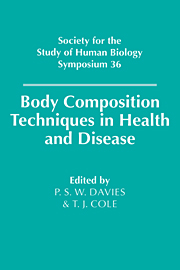Book contents
- Frontmatter
- Contents
- List of contributors
- 1 Application of dual-energy X-ray absorptiometry and related techniques to the assessment of bone and body composition
- 2 In vivo neutron activation analysis: past, present and future
- 3 Magnetic resonance imaging for the assessment of body composition
- 4 Multi-frequency impedance as a measure of body water compartments
- 5 Body composition assessed by electrical conductivity methods
- 6 Body composition in malnutrition
- 7 Influence of body composition on protein and energy requirements: some new insights
- 8 Prediction of adult body composition from infant and child measurements
- 9 Assessment of body composition in the obese
- 10 The role of body physique assessment in sports science
- 11 The assessment of the body composition of populations
- 12 Changes in approach to the measurement of body composition
- 13 Multi-compartment models for the assessment of body composition in health and disease
- 14 The future of body composition research
- Index
2 - In vivo neutron activation analysis: past, present and future
Published online by Cambridge University Press: 18 September 2009
- Frontmatter
- Contents
- List of contributors
- 1 Application of dual-energy X-ray absorptiometry and related techniques to the assessment of bone and body composition
- 2 In vivo neutron activation analysis: past, present and future
- 3 Magnetic resonance imaging for the assessment of body composition
- 4 Multi-frequency impedance as a measure of body water compartments
- 5 Body composition assessed by electrical conductivity methods
- 6 Body composition in malnutrition
- 7 Influence of body composition on protein and energy requirements: some new insights
- 8 Prediction of adult body composition from infant and child measurements
- 9 Assessment of body composition in the obese
- 10 The role of body physique assessment in sports science
- 11 The assessment of the body composition of populations
- 12 Changes in approach to the measurement of body composition
- 13 Multi-compartment models for the assessment of body composition in health and disease
- 14 The future of body composition research
- Index
Summary
Introduction
It is 30 years since the first measurements of the elemental composition of the human body were undertaken by Anderson et al. (1964) using the technique of in vivo neutron activation analysis (IVNAA). Their work followed a report (Hoffman & Hempelmann, 1957) of two nuclear reactor accidents in 1945–6 during which ten persons were exposed to bursts of radiation (fast neutrons and gamma-rays). A measure of the serum 24Na activity induced in the body was used to estimate the neutron intensity to which the subjects had been exposed. It was subsequently realised that a controlled irradiation with neutrons of known intensity could be used as an investigative tool.
The IVNAA technique involves the irradiation of the total or partial body by a beam of neutrons and the detection of characteristic gamma-rays arising from neutron interaction with the nuclei of the element or elements of interest. Although the principle of the technique is simple, the factors that determine the successful measurement of a particular element in vivo can be complex. Nevertheless, IVNAA has been successfully developed at several centres over the last three decades and gained increasing acceptance as a clinically useful, although specialised measurement technique. During this time considerable research has been undertaken to optimise the measurement of both bulk (e.g. Ca, C, Cl, H, N, Na, O and P) and trace (e.g. Al, Cd, Cu, Fe and Si) elements. However, the measurements of calcium, cadmium and nitrogen have been the most widely applied.
- Type
- Chapter
- Information
- Body Composition Techniques in Health and Disease , pp. 14 - 37Publisher: Cambridge University PressPrint publication year: 1995
- 1
- Cited by



